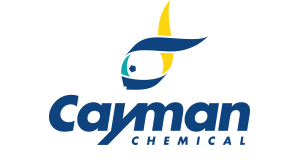Influenza A H5N1 HA1 + HA2 (strain A/barn swallow/Hong Kong/D10-1161/2010) (cleavage site mutant; recombinant)
Influenza A H5N1 HA1 + HA2 (strain A/barn swallow/Hong Kong/D10-1161/2010) (cleavage site mutant; recombinant)
SKU
CAY42016-100
Packaging Unit
100 µg
Manufacturer
Cayman Chemical
Availability:
loading...
Price is loading...
Shelf life (days): 365.0
Formulation: Lyophilized from sterile 20 mM Tris, 500 mM sodium chloride, with 10% glycerol, pH 7.4.
Uniprot ID: L7S370
Purity: ≥95% estimated by SDS-PAGE
Formula Weight: 0.0
Notes: Influenza A H5N1 HA is a type I membrane glycoprotein involved in receptor binding and virus-host cell fusion.{69220,69221,68872} It is produced as a precursor protein, HA0, which is composed of a stalk and head domain and forms homotrimers on the viral surface.{69222,69220} The HA0 precursor is cleaved into subunits, HA1 and HA2, which are responsible for host cell surface receptor binding and endosomal membrane fusion, respectively, and this cleavage is required for endosomal fusion.{69220} For influenza A and influenza B, which are low pathogenic influenza viruses, cleavage occurs via trypsin-like proteases, such as transmembrane serine protease 2 (TMPRSS2), which is essential for influenza A HA, but not influenza B HA, cleavage.{69223,69224,69225} Cleaved influenza A H1N1 HA binds to terminal α2,6- or α2,3-sialic acids on glycoproteins or glycolipids on the host cell surface via the receptor-binding domain in the HA1 subunit, which triggers endocytosis of the virus and trafficking of the vesicle into the endosome.{69222,69226,69227} The low pH environment of the endosome triggers viral rearrangement into a prefusion conformation, and the HA2 subunit facilitates fusion with the endosomal membrane to release viral ribonucleoproteins into the cytosol where they are relocated to the nucleus for viral replication.{69222} A monoclonal antibody targeting a highly conserved epitope of influenza A H5N1 HA1 induces neutralization of influenza A H5N1 pseudoviruses in vitro and prevents mortality in a mouse model of lethal influenza A H5N1 infection.{68873} Cayman's Influenza A H5N1 HA1 + HA2 (strain A/barn swallow/Hong Kong/D10-1161/2010) (cleavage site mutant; recombinant) consists of 524 amino acids, has a calculated molecular weight of 59.8 kDa, a predicted N-terminus of Asp17 after signal peptide cleavage, and contains a TET mutation at the HA1 and HA2 RRRRK cleavage site resulting in an uncleaved HA1 + HA2 construct. By SDS-PAGE, under reducing conditions, the apparent molecular mass of the protein is 58.3 kDa.
Formulation: Lyophilized from sterile 20 mM Tris, 500 mM sodium chloride, with 10% glycerol, pH 7.4.
Uniprot ID: L7S370
Purity: ≥95% estimated by SDS-PAGE
Formula Weight: 0.0
Notes: Influenza A H5N1 HA is a type I membrane glycoprotein involved in receptor binding and virus-host cell fusion.{69220,69221,68872} It is produced as a precursor protein, HA0, which is composed of a stalk and head domain and forms homotrimers on the viral surface.{69222,69220} The HA0 precursor is cleaved into subunits, HA1 and HA2, which are responsible for host cell surface receptor binding and endosomal membrane fusion, respectively, and this cleavage is required for endosomal fusion.{69220} For influenza A and influenza B, which are low pathogenic influenza viruses, cleavage occurs via trypsin-like proteases, such as transmembrane serine protease 2 (TMPRSS2), which is essential for influenza A HA, but not influenza B HA, cleavage.{69223,69224,69225} Cleaved influenza A H1N1 HA binds to terminal α2,6- or α2,3-sialic acids on glycoproteins or glycolipids on the host cell surface via the receptor-binding domain in the HA1 subunit, which triggers endocytosis of the virus and trafficking of the vesicle into the endosome.{69222,69226,69227} The low pH environment of the endosome triggers viral rearrangement into a prefusion conformation, and the HA2 subunit facilitates fusion with the endosomal membrane to release viral ribonucleoproteins into the cytosol where they are relocated to the nucleus for viral replication.{69222} A monoclonal antibody targeting a highly conserved epitope of influenza A H5N1 HA1 induces neutralization of influenza A H5N1 pseudoviruses in vitro and prevents mortality in a mouse model of lethal influenza A H5N1 infection.{68873} Cayman's Influenza A H5N1 HA1 + HA2 (strain A/barn swallow/Hong Kong/D10-1161/2010) (cleavage site mutant; recombinant) consists of 524 amino acids, has a calculated molecular weight of 59.8 kDa, a predicted N-terminus of Asp17 after signal peptide cleavage, and contains a TET mutation at the HA1 and HA2 RRRRK cleavage site resulting in an uncleaved HA1 + HA2 construct. By SDS-PAGE, under reducing conditions, the apparent molecular mass of the protein is 58.3 kDa.
| SKU | CAY42016-100 |
|---|---|
| Manufacturer | Cayman Chemical |
| Manufacturer SKU | 42016-100 |
| Package Unit | 100 µg |
| Quantity Unit | STK |
| Product information (PDF) | Download |
| MSDS (PDF) |
|

 Deutsch
Deutsch










